Browse By Unit
Sumi Vora
Mickey Hansen
Sumi Vora
Mickey Hansen
Welcome to the language of music! In order to read and understand this new language, you will be introduced to various symbols that have specific meanings. Like any new language, by learning these symbols and their meanings, you will be able to converse in the language of music. Let's dive in!
Reading Musical Notes
Musical Staffs
Look at this short example of music:

This is called the grand staff. One staff contains 5 lines and the spaces between those lines are also significant. More on that below!
The top series of 5 lines is called the treble clef 🎼, and the bottom one is called the bass clef. They each have their individual symbol:

On the treble and bass clefs above, you can see the symbols for musical notes (aka, pitch). Each line or space on the staff has a corresponding pitch that a musician will play or sing. The bass clef indicates lower musical notes, and the higher you go up the staff, the higher the frequency of pitch (aka, note). The highest frequencies in music are indicated in the treble clef.
All pitches on a line or space of the staff correspond with a letter name, and range from A to G.
We "read" treble clef and bass clef differently. That means that the middle line of the treble clef will signify a different note than the middle line of the bass clef.
Reading in Treble Clef
Let's start by identifying notes on the treble clef.

The bottom line on the treble clef is an E. The space right above that is an F. The next line is a G. We read the first three notes of this example as E-F-G. You might already see a pattern here! For each line and subsequent space, we go through the alphabet. What happens when we get to G? We start over again at A. The fourth note is A, the 5th note is a B, and the 6th note is a C. See how that works?

Say outloud the order of the alphabet until you get to G and stop. Now can you say the alphabet backwards starting from G and go to A?
There are several ways to remember all the different lines and spaces on the treble clef. Many people use a mnemonic device to remember the order of the lines (E-G-B-D-F). For example, the age-old sentence is: "Every Good Boy Does Fine." If that is familiar and it works for you great, but here are some other examples:
- "Every Good Boy Deserves Fudge"
- "Every Green Bird Does Flips"

The spaces on the treble clef spell one easy word: FACE!

Reading in Bass Clef
On the bass clef, the lowest line is a G, and the lowest space is an A. Here are some ways to remember the bass clef lines (G-B-D-F-A):
- "Good Birds Don't Fly Away"
- "Go Buy Donuts For Al"
- "Grapes, Bananas, Don't Forget Apples"
- "Good Boys Do Fine Always"

Last, but not least, we have the spaces on the bass clef (A-C-E-G)

Mnemonic devices to remember the notes of the bass clef include:
- "All Cows Eat Grass"
- "Anyone Can Enjoy Golf"
Drawing the Clefs
For the music theory exam, you will eventually have to write some music, meaning that you will have to draw the treble and bass clefs. These never have to be perfect, but there are some things that you should know in order to draw the clefs correctly.
For the treble clef, notice that the swirly curls around the G line, and it touches the B and the E lines, but doesn't go beyond them. Also notice that the top of the treble clef goes above the staff.
For the bass clef, notice that the clef does not go higher than the A and does not go lower than the B, and notice that the swirl starts exactly at the F line. A common mistake is to take the bass clef all the way down towards the G, but this would be incorrect.
Ledger Lines
There are also pitches that are indicated outside of the parameters of the staves themselves. Take a look.
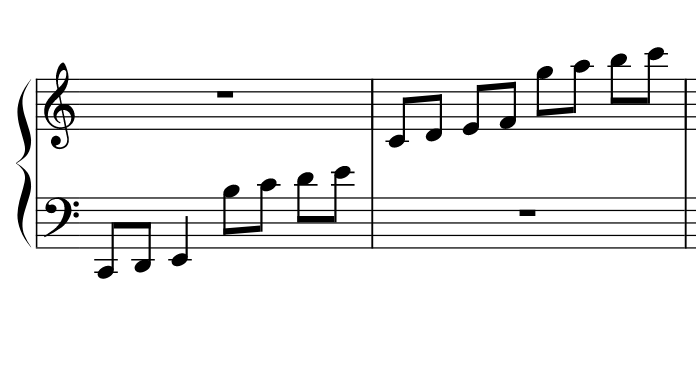
The mini lines that are above or below a staff are called ledger lines. Now take a closer look at the actual pitches, especially on the ledger lines between the staves. Can you name these notes?
Just like on the regular staff, you count the spaces and lines the same when continuing the alphabet upwards on the staff.
Identify the notes below.
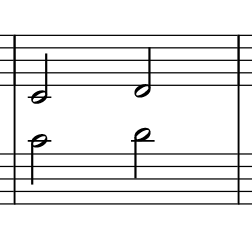
Not a trick question! The above pitches are indeed the same, we just place them differently for each clef.
Now take a look at the image below and determine the last notes.
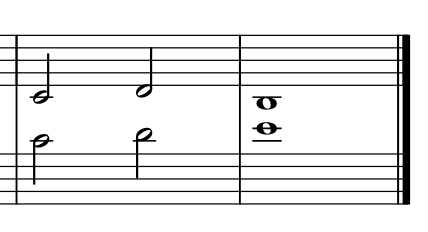
You'll find that the pitch on the bass clef is actually higher than the note on the treble clef. Identifying these crossed pitches becomes very important in Section 4.1.
Alto and Tenor Clefs
While most instruments read in the treble or bass clefs, there are some instruments who use the alto and tenor clefs, aka the "c" clefs. You will do most of your musical writing using the grand staff, so you don't have to be super comfortable with writing in the c clefs, but you may encounter a few multiple choice questions that use these clefs.
Alto Clef
Only the viola uses alto clef, although historically, alto clef was also used by altos in a choir (hence the name). Here is what an alto clef looks like:
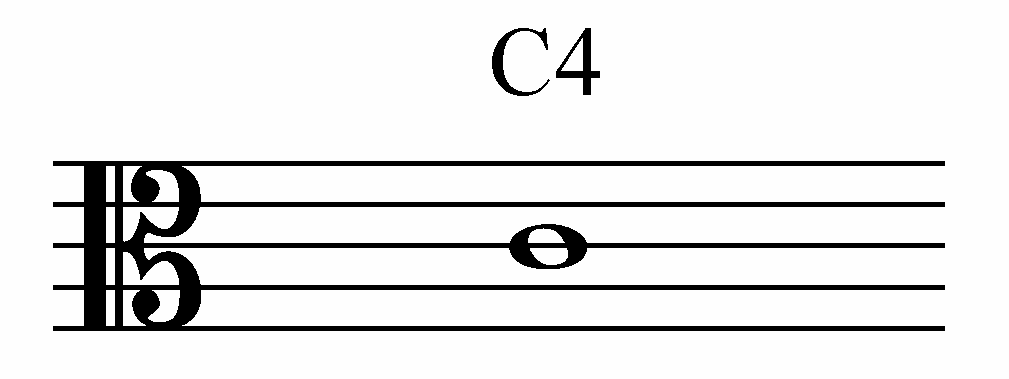
In both the alto and the tenor clef, middle c falls right in between the two Cs on the clef. So, the lines will have notes F-A-C-E-G, and the spaces will have notes G-B-D-F. You can use mnemonics to memorize these, but it might be easier to just memorize the position of Middle C and count up and down accordingly. If you are trying to learn all the clefs at once, it is easy to confuse which staff uses which mnemonic.
Tenor Clef
Tenor clef is quite similar to alto clef, but Middle C is on the fourth line, so tenor clef is used for notating slightly lower registers. Cello and bassoon generally use tenor clef. Just like alto clef, the middle C is in between the C's on the clef, so even if you forget which one is alto clef and which one is tenor clef, you will still be able to read the notes.
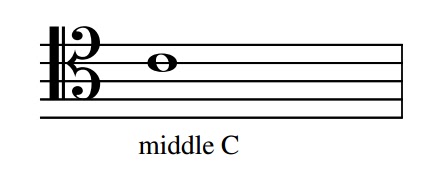
The distance between notes makes up what is called an interval. One specific interval is called an octave. An octave is the distance between one note (such as an E) and another E higher or lower than the original. The note is identified by ear as the same but is just higher or lower in frequency.
Measures
Let's take a look again at the original example of music we first saw.

The notes are organized into measures. The vertical line that spans between the treble and bass clefs indicate the end of a measure. Sometimes measures are called bars. The line can also be called a bar line.

Accidentals
Now that you know pitches and measures, there are three symbols we need to look at. The "sharp" ♯ indicates that a pitch will go up by one half step.

The "flat" ♭ indicates that a pitch will go down by one half step.

The "natural" ♮ cancels any flat or sharp that a pitch may have had.
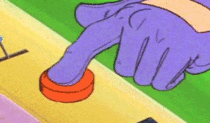
These three symbols make up the category called "accidentals". Accidentals should always be placed to the LEFT of the notehead.

Each pitch can be notated in several ways. We call this enharmonic equivalents. For example, an A-sharp sounds the same as a B-flat. They have different names, but they sound the same.
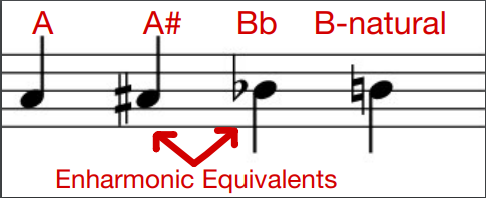
The operating rule of accidentals is as follows: when an accidental is indicated in music, it will be valid for that one pitch through the end of the measure, even when the pitch comes back again. The end of the measure cancels the accidental.
Introduction to Intervals and Melodies
Now that you know how to read notes, it is time to learn about intervals. An interval is the space between two notes. These notes can be played together or separately, but there will only be two of them. If there are three or more notes, then it is a chord, which we will learn about later.
A melody is a sequence of notes combined with a rhythm. A melody will have specific notes, but the melody that we recognize often has more to do with the intervals, or the space between the notes. For example, you might think of the melody of "Happy Birthday." Each time you hear "Happy Birthday," it might start on a slightly different pitch. However, you will still recognize the melody because of the way that pitches are organized relative to one another. This is called relative pitch.
After we learn more, we will be able to identify specific intervals (e.g. minor 3rd, major 6th, etc.). There will be a section on the exam where you will hear a melody and you will have to notate it given a specific starting note, meaning that you only need to have relative pitch. There will also be a section on the exam where you have to sight-sing a given melody, which is a skill that also utilizes relative pitch.
Relative pitch is a skill that you develop over time. You have to train your ears to be able to discern certain intervals. Chances are, if you have been playing music for a while, you might already have good relative pitch for certain intervals. For example, if you're a violinist, it might be easy for you to recognize perfect 5ths, because you use them to tune your violin. However, more obscure intervals might be harder to recognize. We recommend practicing relative pitch early on - this is not a skill that you can cram for!
<< Hide Menu
Sumi Vora
Mickey Hansen
Sumi Vora
Mickey Hansen
Welcome to the language of music! In order to read and understand this new language, you will be introduced to various symbols that have specific meanings. Like any new language, by learning these symbols and their meanings, you will be able to converse in the language of music. Let's dive in!
Reading Musical Notes
Musical Staffs
Look at this short example of music:

This is called the grand staff. One staff contains 5 lines and the spaces between those lines are also significant. More on that below!
The top series of 5 lines is called the treble clef 🎼, and the bottom one is called the bass clef. They each have their individual symbol:

On the treble and bass clefs above, you can see the symbols for musical notes (aka, pitch). Each line or space on the staff has a corresponding pitch that a musician will play or sing. The bass clef indicates lower musical notes, and the higher you go up the staff, the higher the frequency of pitch (aka, note). The highest frequencies in music are indicated in the treble clef.
All pitches on a line or space of the staff correspond with a letter name, and range from A to G.
We "read" treble clef and bass clef differently. That means that the middle line of the treble clef will signify a different note than the middle line of the bass clef.
Reading in Treble Clef
Let's start by identifying notes on the treble clef.

The bottom line on the treble clef is an E. The space right above that is an F. The next line is a G. We read the first three notes of this example as E-F-G. You might already see a pattern here! For each line and subsequent space, we go through the alphabet. What happens when we get to G? We start over again at A. The fourth note is A, the 5th note is a B, and the 6th note is a C. See how that works?

Say outloud the order of the alphabet until you get to G and stop. Now can you say the alphabet backwards starting from G and go to A?
There are several ways to remember all the different lines and spaces on the treble clef. Many people use a mnemonic device to remember the order of the lines (E-G-B-D-F). For example, the age-old sentence is: "Every Good Boy Does Fine." If that is familiar and it works for you great, but here are some other examples:
- "Every Good Boy Deserves Fudge"
- "Every Green Bird Does Flips"

The spaces on the treble clef spell one easy word: FACE!

Reading in Bass Clef
On the bass clef, the lowest line is a G, and the lowest space is an A. Here are some ways to remember the bass clef lines (G-B-D-F-A):
- "Good Birds Don't Fly Away"
- "Go Buy Donuts For Al"
- "Grapes, Bananas, Don't Forget Apples"
- "Good Boys Do Fine Always"

Last, but not least, we have the spaces on the bass clef (A-C-E-G)

Mnemonic devices to remember the notes of the bass clef include:
- "All Cows Eat Grass"
- "Anyone Can Enjoy Golf"
Drawing the Clefs
For the music theory exam, you will eventually have to write some music, meaning that you will have to draw the treble and bass clefs. These never have to be perfect, but there are some things that you should know in order to draw the clefs correctly.
For the treble clef, notice that the swirly curls around the G line, and it touches the B and the E lines, but doesn't go beyond them. Also notice that the top of the treble clef goes above the staff.
For the bass clef, notice that the clef does not go higher than the A and does not go lower than the B, and notice that the swirl starts exactly at the F line. A common mistake is to take the bass clef all the way down towards the G, but this would be incorrect.
Ledger Lines
There are also pitches that are indicated outside of the parameters of the staves themselves. Take a look.

The mini lines that are above or below a staff are called ledger lines. Now take a closer look at the actual pitches, especially on the ledger lines between the staves. Can you name these notes?
Just like on the regular staff, you count the spaces and lines the same when continuing the alphabet upwards on the staff.
Identify the notes below.

Not a trick question! The above pitches are indeed the same, we just place them differently for each clef.
Now take a look at the image below and determine the last notes.

You'll find that the pitch on the bass clef is actually higher than the note on the treble clef. Identifying these crossed pitches becomes very important in Section 4.1.
Alto and Tenor Clefs
While most instruments read in the treble or bass clefs, there are some instruments who use the alto and tenor clefs, aka the "c" clefs. You will do most of your musical writing using the grand staff, so you don't have to be super comfortable with writing in the c clefs, but you may encounter a few multiple choice questions that use these clefs.
Alto Clef
Only the viola uses alto clef, although historically, alto clef was also used by altos in a choir (hence the name). Here is what an alto clef looks like:

In both the alto and the tenor clef, middle c falls right in between the two Cs on the clef. So, the lines will have notes F-A-C-E-G, and the spaces will have notes G-B-D-F. You can use mnemonics to memorize these, but it might be easier to just memorize the position of Middle C and count up and down accordingly. If you are trying to learn all the clefs at once, it is easy to confuse which staff uses which mnemonic.
Tenor Clef
Tenor clef is quite similar to alto clef, but Middle C is on the fourth line, so tenor clef is used for notating slightly lower registers. Cello and bassoon generally use tenor clef. Just like alto clef, the middle C is in between the C's on the clef, so even if you forget which one is alto clef and which one is tenor clef, you will still be able to read the notes.

The distance between notes makes up what is called an interval. One specific interval is called an octave. An octave is the distance between one note (such as an E) and another E higher or lower than the original. The note is identified by ear as the same but is just higher or lower in frequency.
Measures
Let's take a look again at the original example of music we first saw.

The notes are organized into measures. The vertical line that spans between the treble and bass clefs indicate the end of a measure. Sometimes measures are called bars. The line can also be called a bar line.

Accidentals
Now that you know pitches and measures, there are three symbols we need to look at. The "sharp" ♯ indicates that a pitch will go up by one half step.

The "flat" ♭ indicates that a pitch will go down by one half step.

The "natural" ♮ cancels any flat or sharp that a pitch may have had.

These three symbols make up the category called "accidentals". Accidentals should always be placed to the LEFT of the notehead.

Each pitch can be notated in several ways. We call this enharmonic equivalents. For example, an A-sharp sounds the same as a B-flat. They have different names, but they sound the same.

The operating rule of accidentals is as follows: when an accidental is indicated in music, it will be valid for that one pitch through the end of the measure, even when the pitch comes back again. The end of the measure cancels the accidental.
Introduction to Intervals and Melodies
Now that you know how to read notes, it is time to learn about intervals. An interval is the space between two notes. These notes can be played together or separately, but there will only be two of them. If there are three or more notes, then it is a chord, which we will learn about later.
A melody is a sequence of notes combined with a rhythm. A melody will have specific notes, but the melody that we recognize often has more to do with the intervals, or the space between the notes. For example, you might think of the melody of "Happy Birthday." Each time you hear "Happy Birthday," it might start on a slightly different pitch. However, you will still recognize the melody because of the way that pitches are organized relative to one another. This is called relative pitch.
After we learn more, we will be able to identify specific intervals (e.g. minor 3rd, major 6th, etc.). There will be a section on the exam where you will hear a melody and you will have to notate it given a specific starting note, meaning that you only need to have relative pitch. There will also be a section on the exam where you have to sight-sing a given melody, which is a skill that also utilizes relative pitch.
Relative pitch is a skill that you develop over time. You have to train your ears to be able to discern certain intervals. Chances are, if you have been playing music for a while, you might already have good relative pitch for certain intervals. For example, if you're a violinist, it might be easy for you to recognize perfect 5ths, because you use them to tune your violin. However, more obscure intervals might be harder to recognize. We recommend practicing relative pitch early on - this is not a skill that you can cram for!

© 2025 Fiveable Inc. All rights reserved.